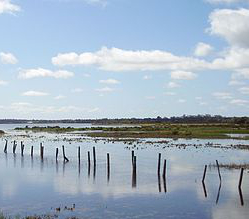Renewal flows in flood's wake
 Floods brought new threats to Wingillie Wetlands, but nature is fighting back.
Floods brought new threats to Wingillie Wetlands, but nature is fighting back.
The Wingillie Wetlands in south-western New South Wales are showing strong signs of ecological recovery after the devastating 2022 floods, according to the Commonwealth Environmental Water Holder (CEWH).
Once submerged under floodwaters that turned the landscape into an “inland sea”, the wetlands are witnessing a resurgence of biodiversity, reversing years of environmental stress.
Located on Barkindji and Maraura Country, Wingillie Station has endured cycles of drought, flood, and regeneration.
Since 2015, CEWH, in partnership with Hazel L Henry Farmland Nature Refuges Trust, the Murray-Darling Wetlands Working Group (MDWWG), NSW Fisheries, and other environmental bodies, has worked to restore these vital wetlands.
“The amazing thing about wetlands is that no one year is ever the same. They're so dynamic, you never know exactly what plants or animals will pop up where. It’s a process of continual learning,” said Sascha Healy, Senior Environmental Water Manager at MDWWG.
The 2022 flood, one of the largest recorded in the Murray River's history, delivered both benefits and challenges.
While the floodwaters revitalised habitats, enabling waterbirds to breed prolifically and supporting native fish like the endangered Murray hardyhead, they also triggered a surge of invasive European carp.
“The flood turned Wingillie into an inland sea,” Healy recalled.
“The amount of wildlife in the wake of a flood, from bird breeding to the southern bell frog populations, was wonderful to witness.”
However, the same conditions that supported native species also created ideal breeding grounds for carp, threatening to undo years of restoration work.
To combat the carp invasion, water managers dried out large sections of the wetlands throughout 2023-24. This natural drying process, aided by high evaporation rates, aimed to eradicate the carp population without harming native species.
“This was the only way we could completely eradicate the carp from key Wingillie wetlands,” Healy explained.
Specific lagoons were maintained as refuges for vulnerable species like the threatened southern bell frog.
A screening pump with ultra-fine mesh filters was introduced to prevent carp eggs from entering the wetlands during water reintroduction.
“With the carp screen, it takes carp out of the equation. We can base watering actions purely on when the system needs it,” Healy said.
These measures are paying off.
The Murray hardyhead, once thought extinct in NSW, has rebounded spectacularly. From a few hundred reintroduced individuals in Little Frenchman’s Creek, numbers soared to over 200,000 by 2021, with expectations of further growth after the floods.
The southern bell frog, another priority species under the Threatened Species Action Plan, has expanded its range significantly, its distinctive call now heard across Wingillie.
“The proliferation of wildlife in the wake of a flood event, from bird breeding to the identification of the southern bell frog, has been wonderful to witness, and shows how important wetland management is,” said Ken Warren from HLH Nature Refuges.
Wingillie’s recovery highlights the importance of sustained water management in reversing global wetland loss.
Over 3.4 million square kilometres of wetlands have been lost worldwide, an area larger than Western Australia and New South Wales combined.
As climate change and invasive species continue to threaten Australia’s wetlands, Wingillie Station offers a blueprint for resilience.
“The return of the Murray hardyhead at this site is a great achievement and follows years of hard work by local landholders, community groups, and agencies to create suitable conditions,” said Dr Simon Banks, Commonwealth Environmental Water Holder.
“This is a great example of how water for the environment is targeted and used carefully to improve the health of our rivers and wetlands.”








 Print
Print